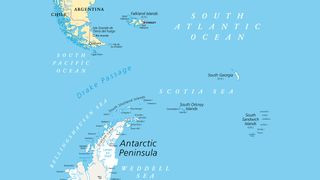Have you seen viral videos online showcasing a stark line in the ocean, with waters of different colors refusing to blend? These videos often suggest this phenomenon as proof that the Pacific and Atlantic Oceans remain separate, never mixing. But is this visual trickery the real story of Where The Pacific And Atlantic Meet?
The truth, according to oceanographers, is far more nuanced and fascinating. Yes, the Pacific and Atlantic Oceans do indeed mix. In reality, they are constantly exchanging waters, although the process isn’t always as instantaneous or visually dramatic as pouring cream into coffee. Think of it more like a slow, swirling dance where different water masses gradually intertwine.
Debunking the Myth: Do the Pacific and Atlantic Oceans Really Mix?
The claim that the Pacific and Atlantic Oceans don’t mix is simply false. As Nadín Ramírez, an oceanographer at the University of Concepción in Chile, plainly states, “The short answer is yes! The waters are constantly mixing.” The apparent lines seen in viral videos are often natural phenomena occurring where different bodies of water converge, but they don’t signify absolute separation. These lines can be caused by variations in salinity, temperature, or sediment content, especially where rivers or glacial meltwater meet the ocean.
These visual boundaries are temporary and eventually dissolve as the waters interact. To understand why, it’s helpful to consider the dynamics of ocean mixing.
The Science of Ocean Mixing: Density, Salinity, and Temperature
Imagine stirring cream into coffee. At first, you see distinct swirls, but with time and stirring, the cream fully incorporates into the coffee, creating a homogenous mixture. Ocean mixing operates on a similar principle, albeit on a vastly larger scale and influenced by factors like density, salinity, and temperature.
Differences in these properties can create visible lines where water masses meet. For instance, freshwater from glaciers is less dense than saltwater, leading to temporary stratification. Saltier, colder, or cleaner water might appear distinct from less salty, warmer, or sediment-rich water. However, these are differences in properties, not impermeable barriers.
The Cream in Coffee Analogy
The analogy of cream dissolving in coffee is particularly apt. The initial swirling and slow integration represent the natural pace of ocean mixing. In areas with less turbulence, like deeper ocean layers, this mixing is indeed slower. However, just as vigorous stirring speeds up the cream’s dissolution, strong winds and powerful currents act as the ocean’s stirrers, accelerating the mixing process.
Key Locations Where the Pacific and Atlantic Meet
The most significant meeting point of the Pacific and Atlantic Oceans is around the southern tip of South America. This region, characterized by a fragmented coastline and numerous islands, presents diverse mixing scenarios.
The Strait of Magellan: A Visible Boundary?
The Strait of Magellan, a navigable sea route separating mainland South America from islands to the south, is one such area. Here, glacial meltwater flows into the ocean, creating noticeable lines where freshwater and saltwater meet. These lines, similar to those in viral videos, are often cited as evidence of ocean separation.
However, even in the Strait of Magellan, the waters are mixing. Oceanographers, using precise measurements, can detect a “blue tongue of water” from the Pacific flowing into the Atlantic. This Pacific water, less salty due to higher rainfall, retains its distinct properties for a while before storms and waves eventually blur the line and fully integrate it with the Atlantic waters.
The Drake Passage: Nature’s Mixing Machine
Further south, between South America and Antarctica, lies the Drake Passage. This area is renowned for its turbulent waters and colossal waves, sometimes reaching up to 60 feet (18 meters). The Drake Passage is a crucial zone for ocean mixing. “That improves the mix,” notes Ramírez, highlighting the role of turbulence in breaking down water mass differences.
 Map showing the Drake Passage between South America and Antarctica, highlighting its role in mixing the Pacific and Atlantic Oceans.
Map showing the Drake Passage between South America and Antarctica, highlighting its role in mixing the Pacific and Atlantic Oceans.
Drake Passage: A key area where the Pacific and Atlantic oceans meet and intensely mix due to turbulent waters and strong currents.
The Mechanisms of Ocean Mixing: Currents and Turbulence
Ocean mixing isn’t solely reliant on surface turbulence. Deep within the ocean, tides play a significant role. Casimir de Lavergne, a researcher at Sorbonne University and the French National Center for Scientific Research (CNRS), explains that daily tides dragging water across the uneven seafloor generate considerable turbulence, contributing to vertical mixing throughout the water column.
Furthermore, global ocean currents act as massive conveyor belts, constantly exchanging water between ocean basins. The Antarctic Circumpolar Current, a powerful current flowing around Antarctica, pulls water from the Pacific into the Atlantic through the Drake Passage. Another current system transports Pacific water through the Indian Ocean, around the tip of South Africa, and into the Atlantic from the east.
While these currents facilitate a continuous exchange of water, the ocean also exhibits stratification, forming layers with distinct properties. These layers, termed “clines,” can persist for extended periods, especially in the ocean’s mid-layers where turbulence is minimal. However, even these layers are not entirely isolated and experience gradual mixing over time.
Climate Change Impact: Slowing Down Ocean Mixing?
The ongoing phenomenon of climate change is now impacting the dynamics of ocean mixing. Scientists have observed a slowing down of ocean currents, particularly around Antarctica. Warmer, less salty water from melting ice sheets reduces the density difference between surface and deep waters, hindering the sinking of cold, salty water that drives deep ocean currents.
This slowdown in currents also affects the rate of ocean mixing. As the density differences between water layers increase due to melting ice, the process of averaging out these differences becomes slower. This has implications for global ocean circulation, nutrient distribution, and ultimately, marine ecosystems.
Conclusion: A Constant, Changing Process
In conclusion, the idea that the Pacific and Atlantic Oceans do not mix is a misconception fueled by misleading online videos. The reality is that these oceans are in constant communication, exchanging and mixing waters through a complex interplay of currents, turbulence, and density gradients.
While dramatic visual lines can appear where different water masses converge, these are temporary boundaries, not permanent walls. The mixing process, though sometimes slow and layered, is fundamental to the Earth’s ocean system. However, climate change is now introducing new complexities, potentially altering the pace and patterns of ocean mixing with consequences that scientists are still working to fully understand. The meeting of the Pacific and Atlantic is not a static line, but a dynamic, ever-evolving zone of interaction in our changing world.

